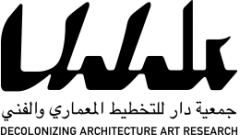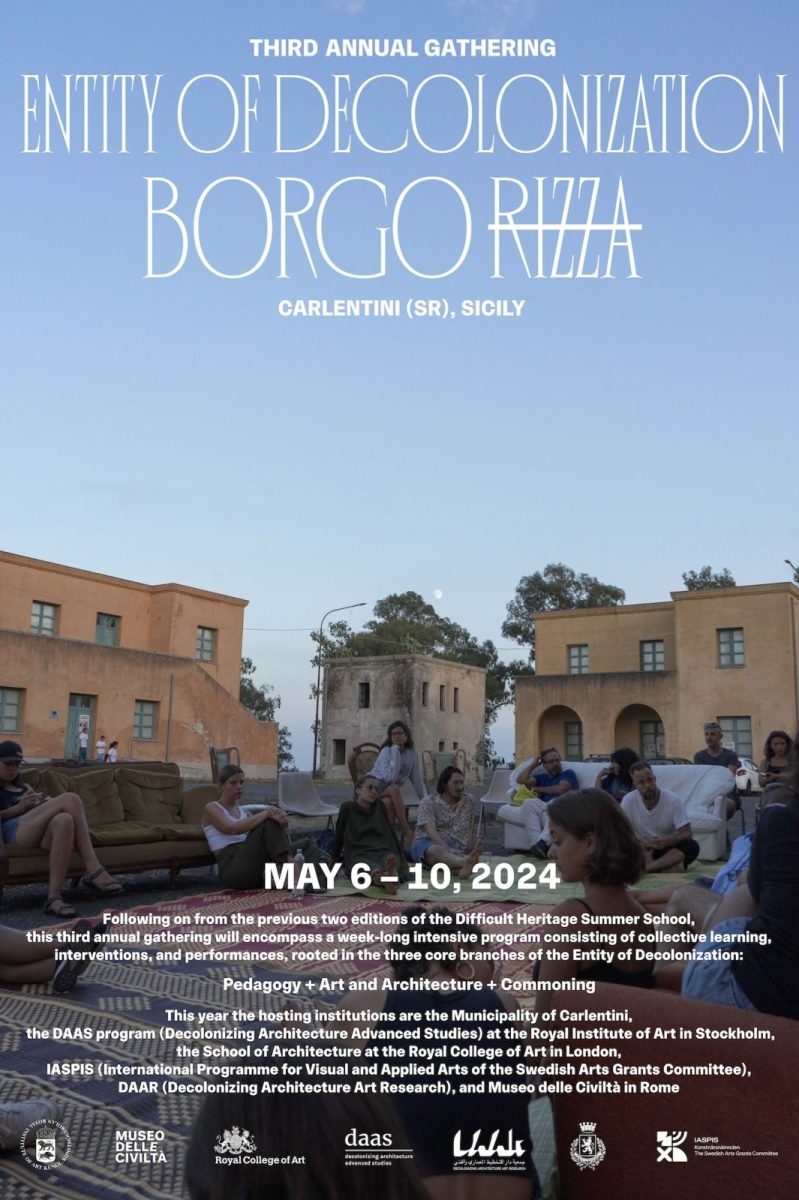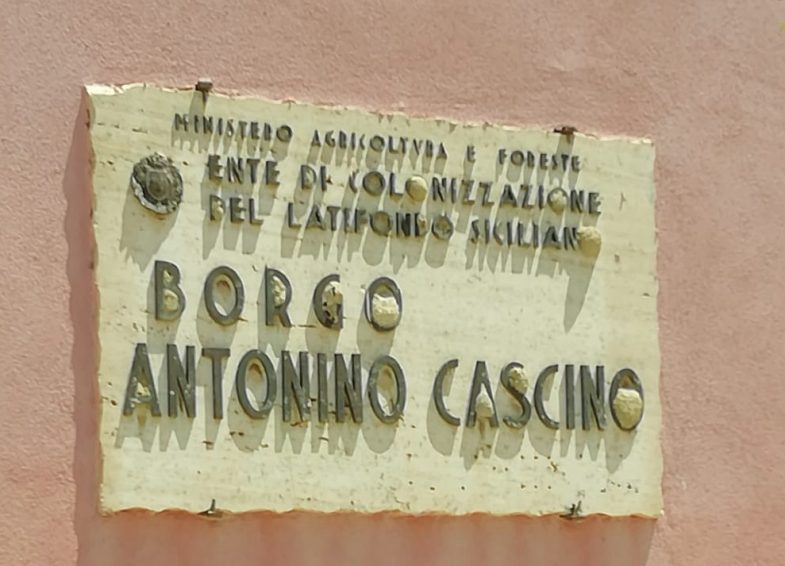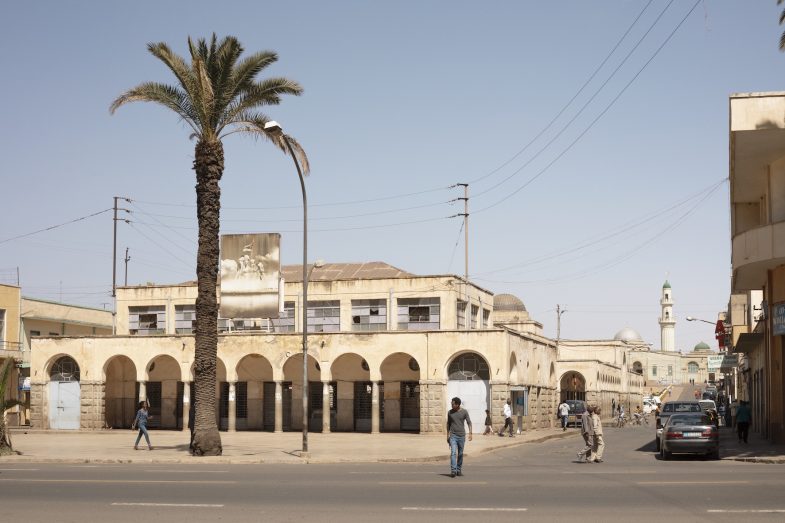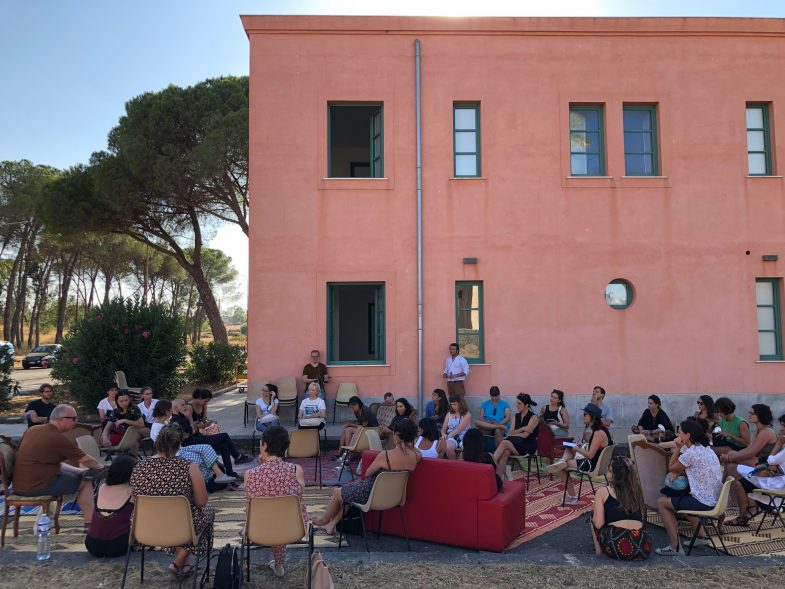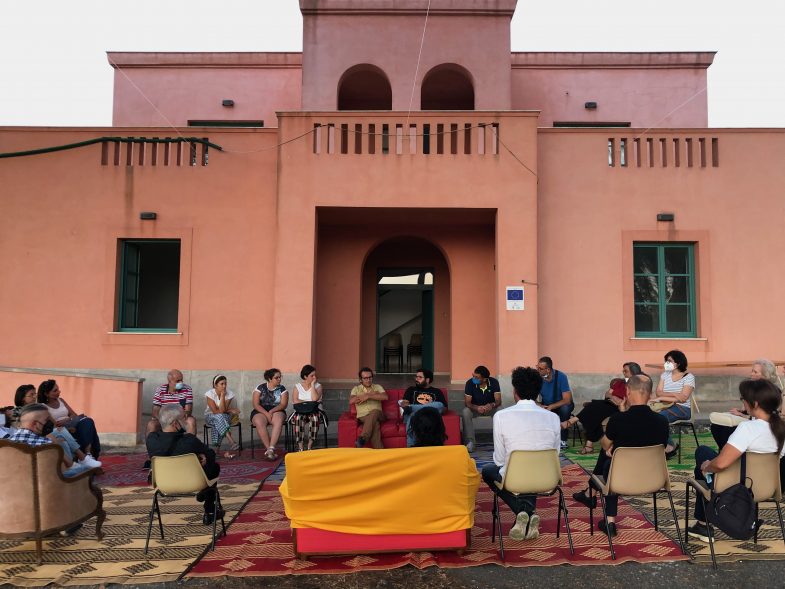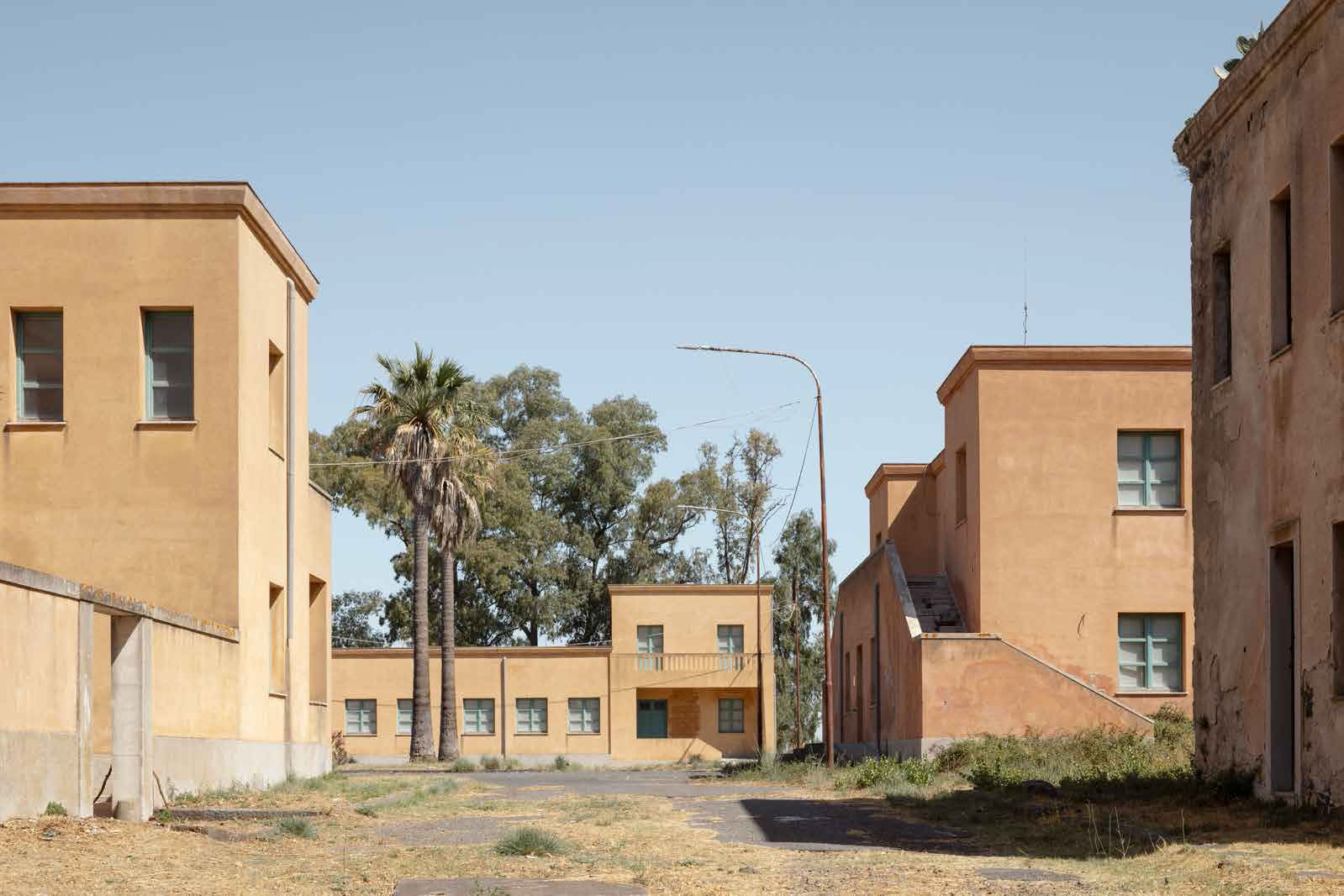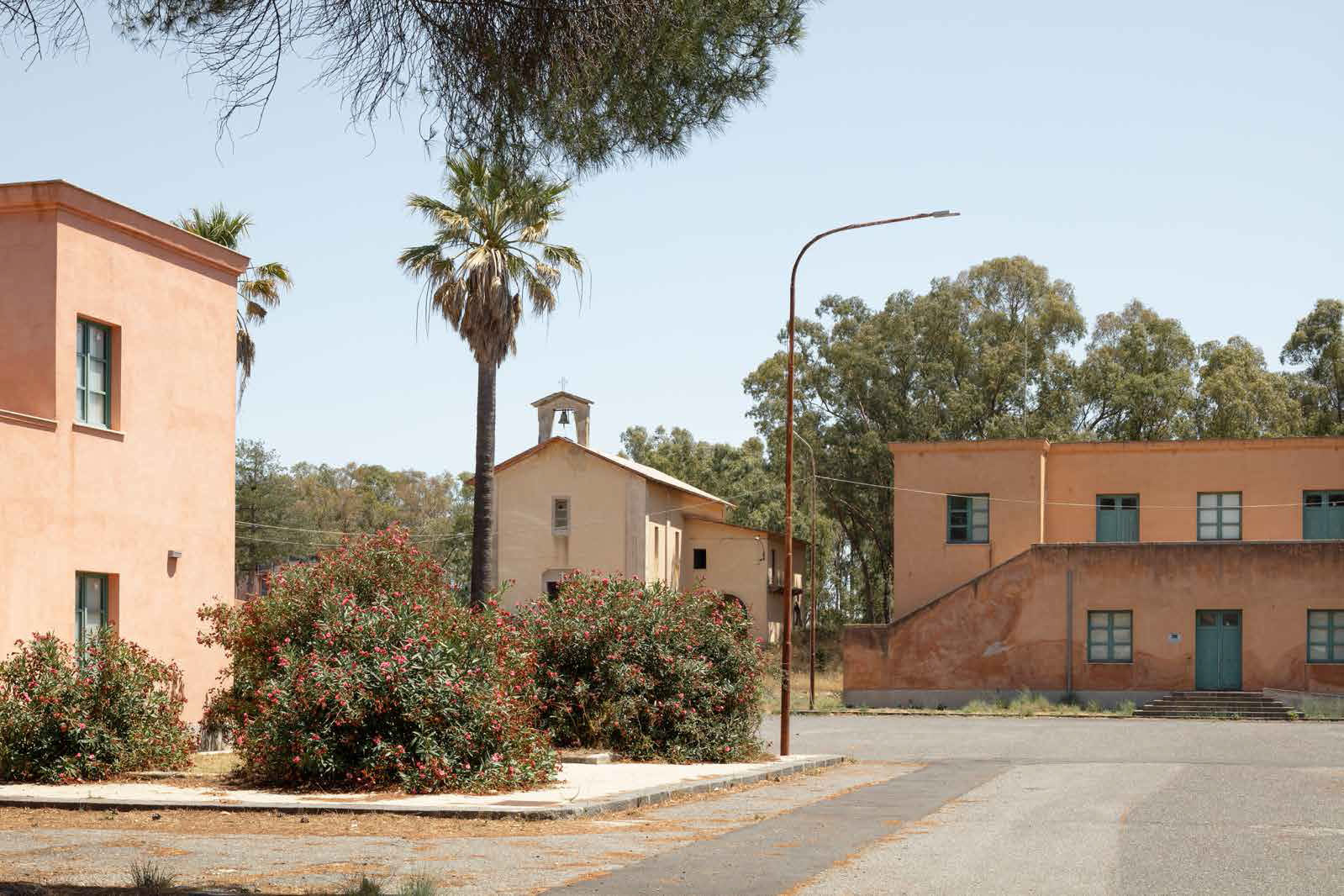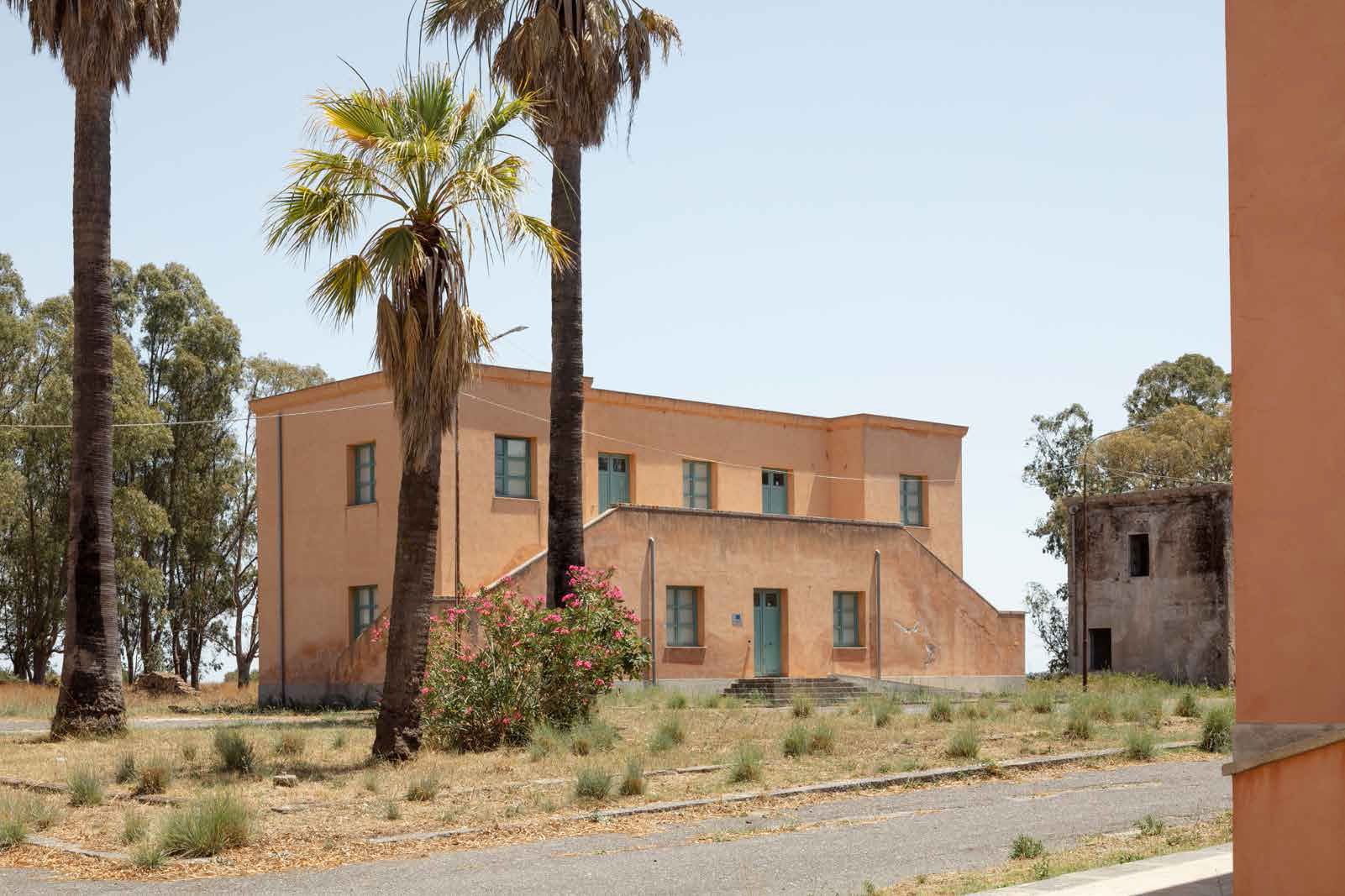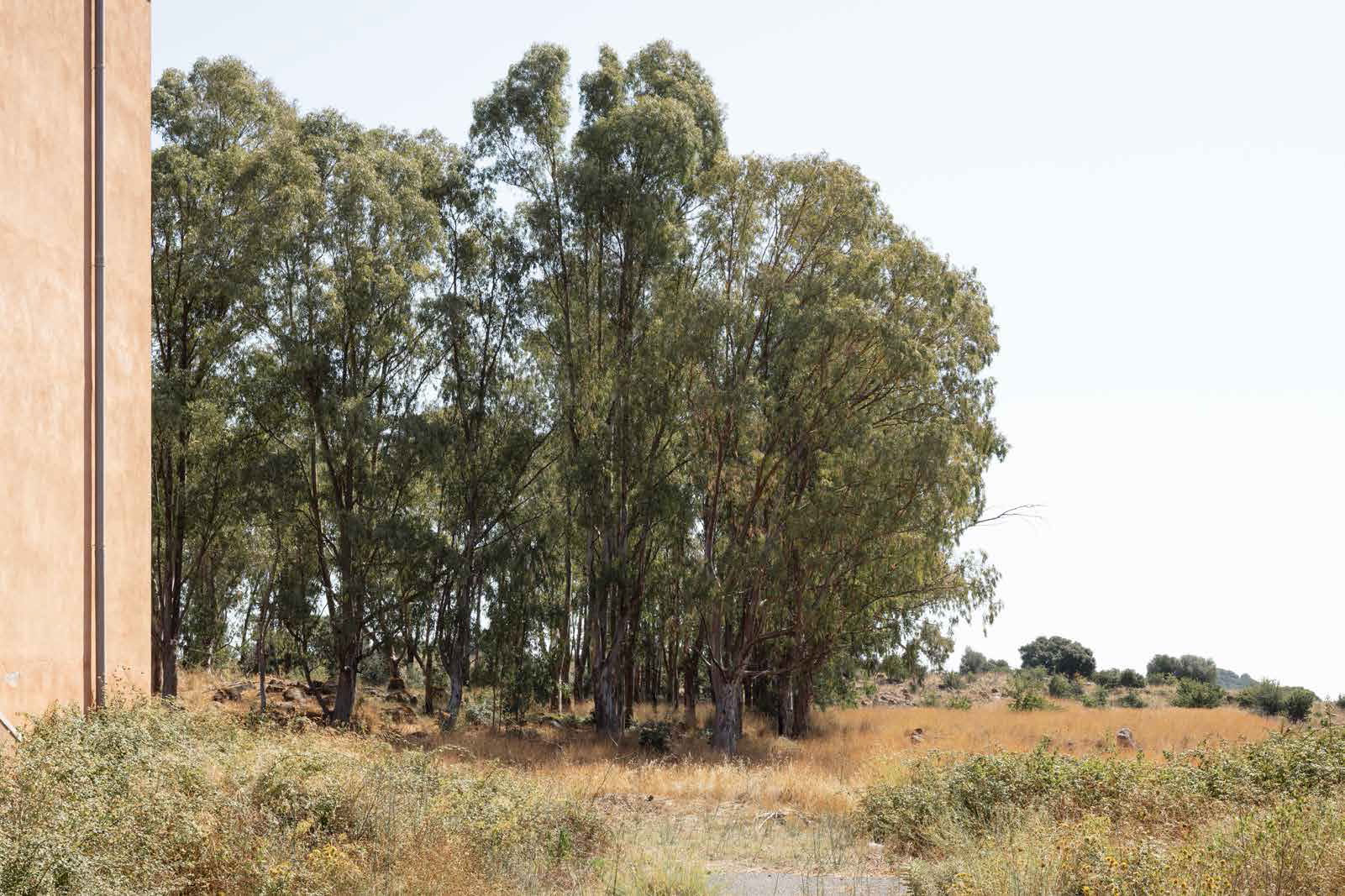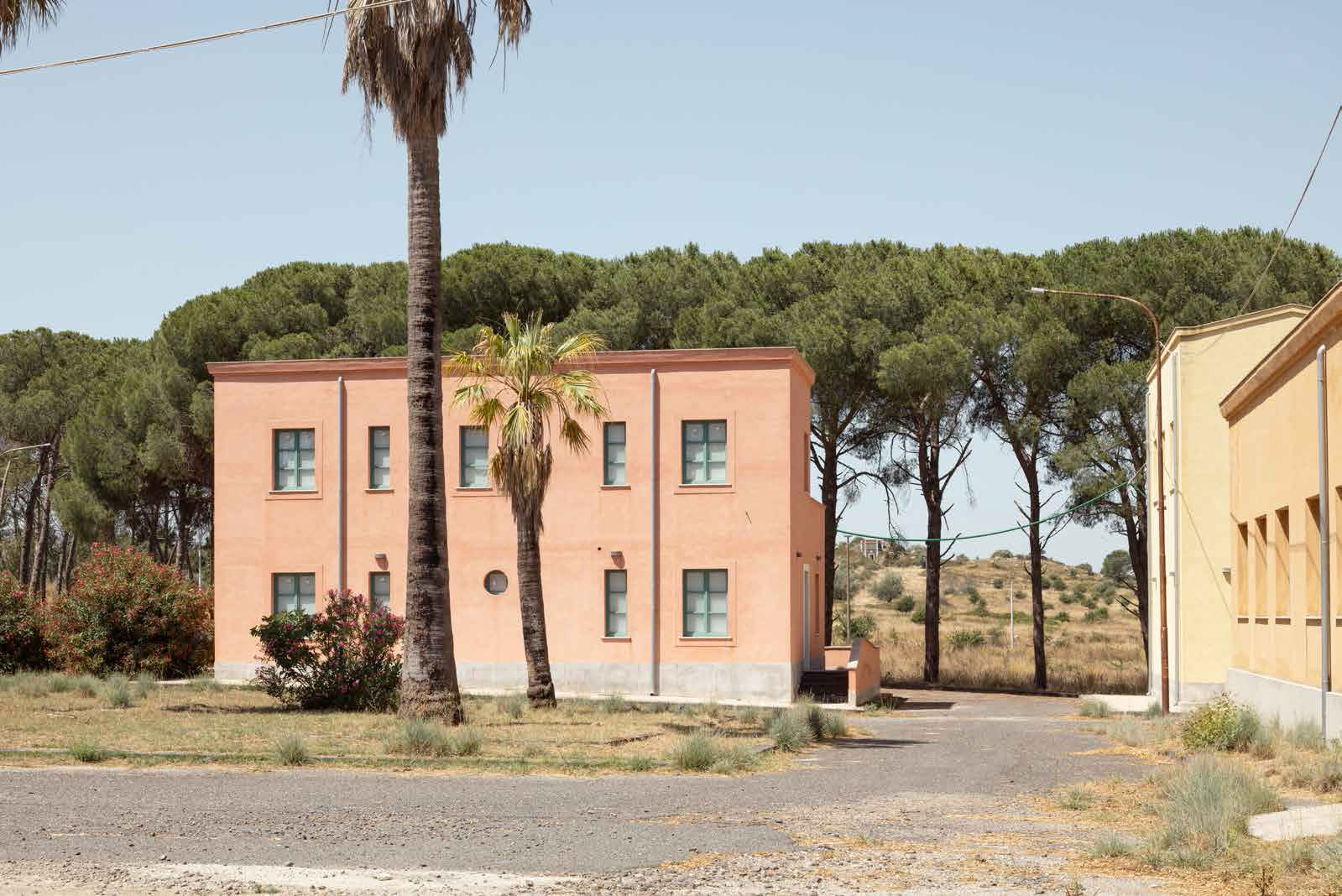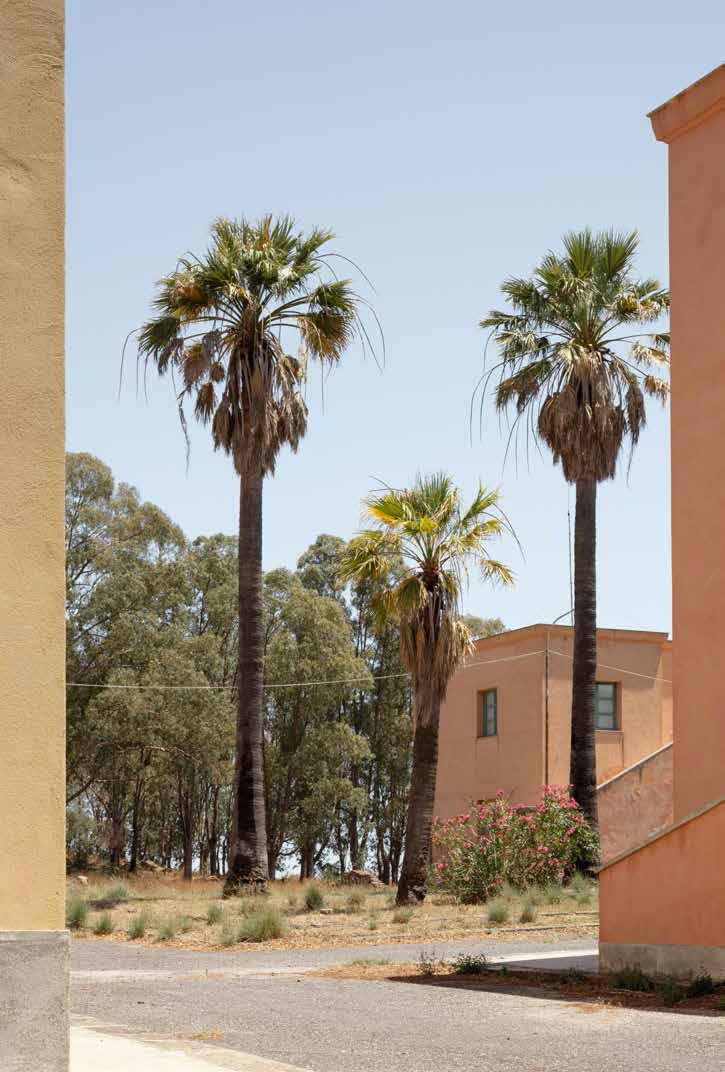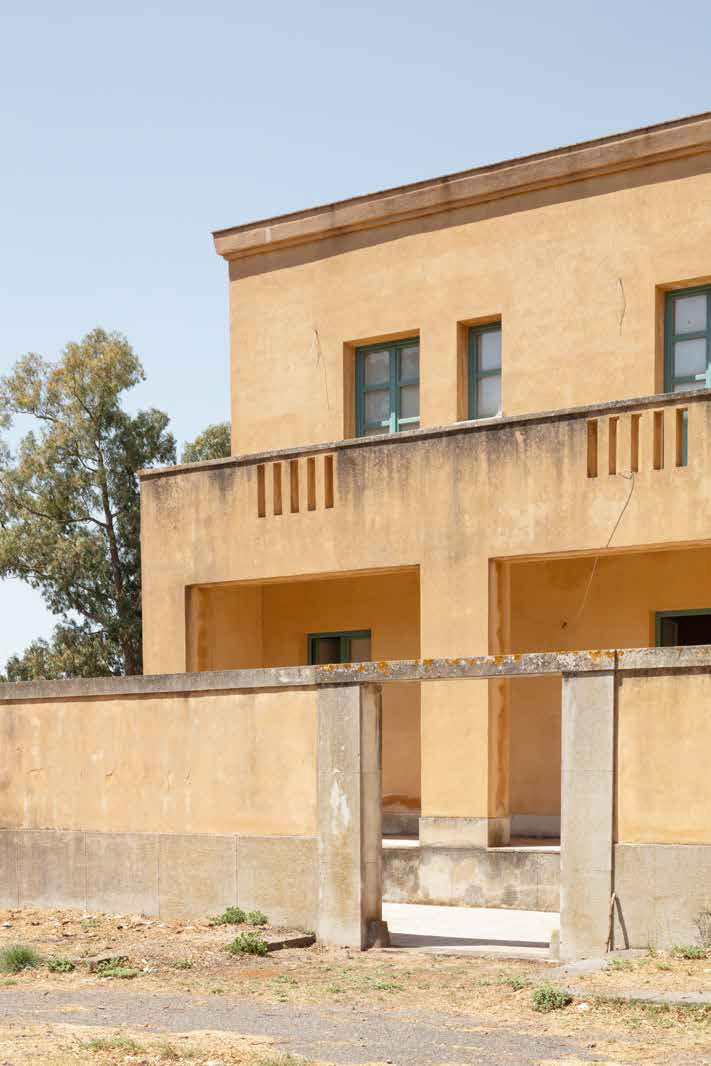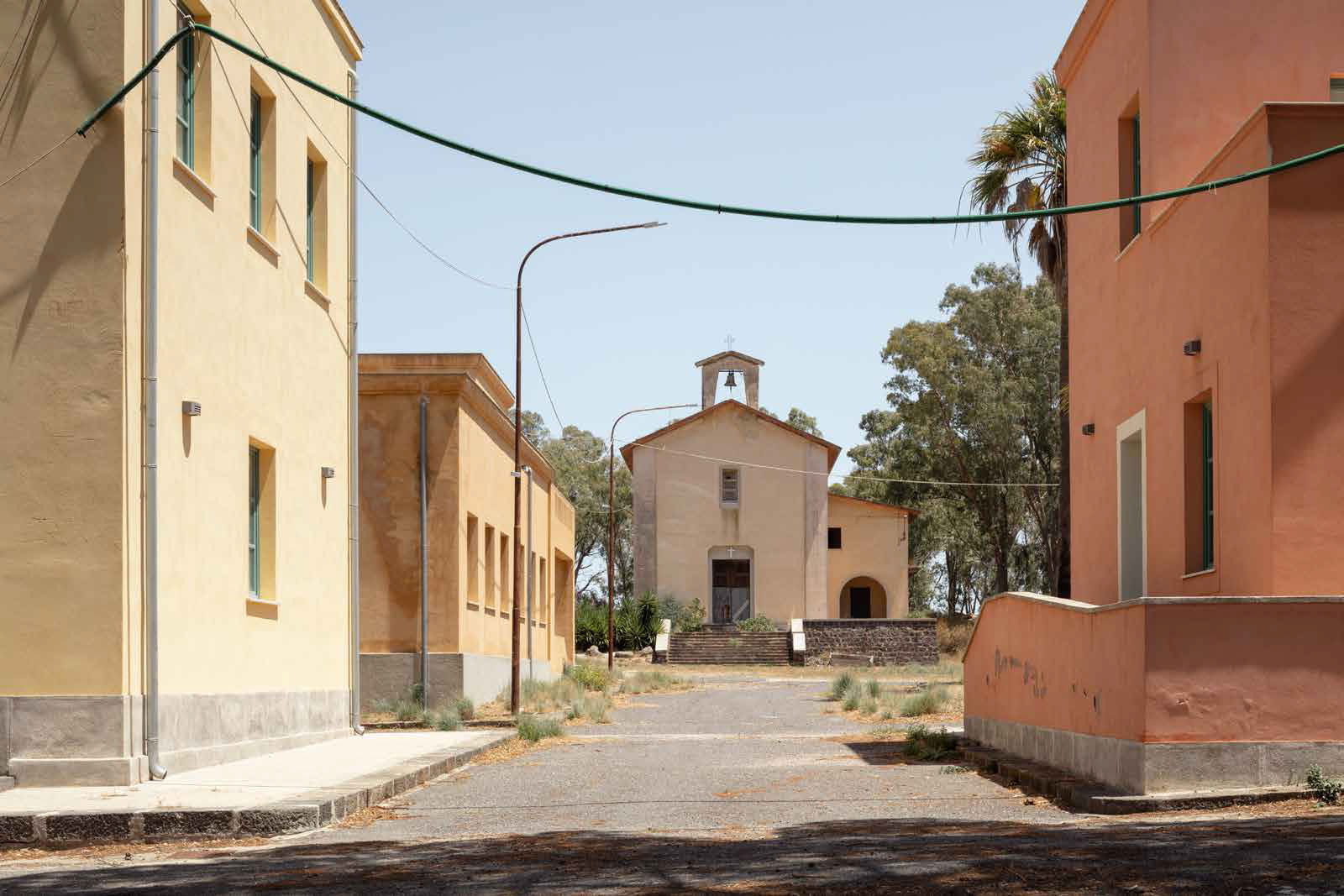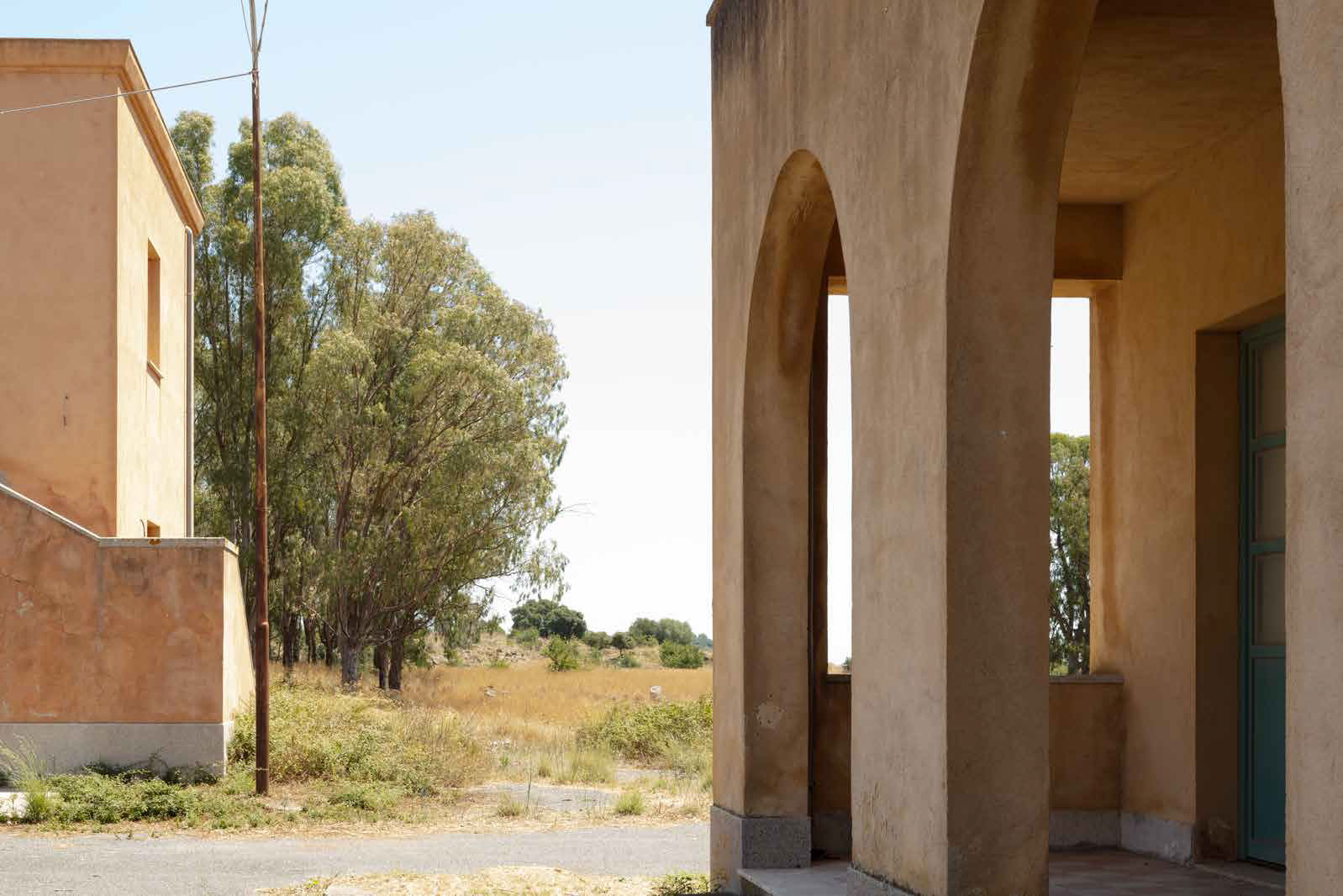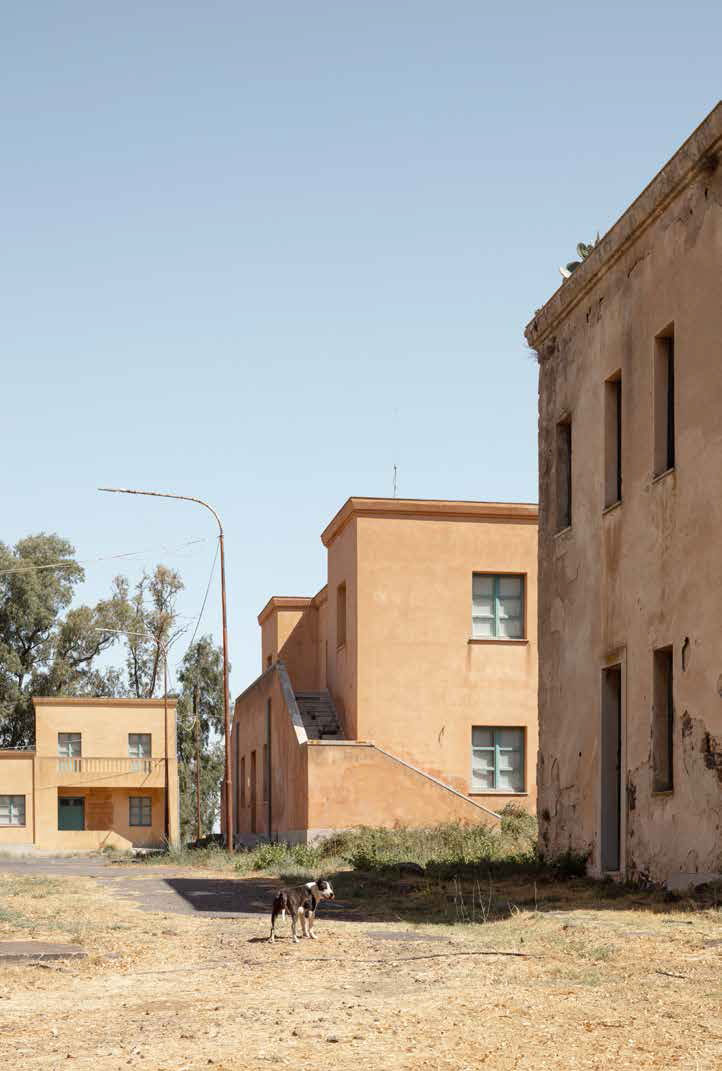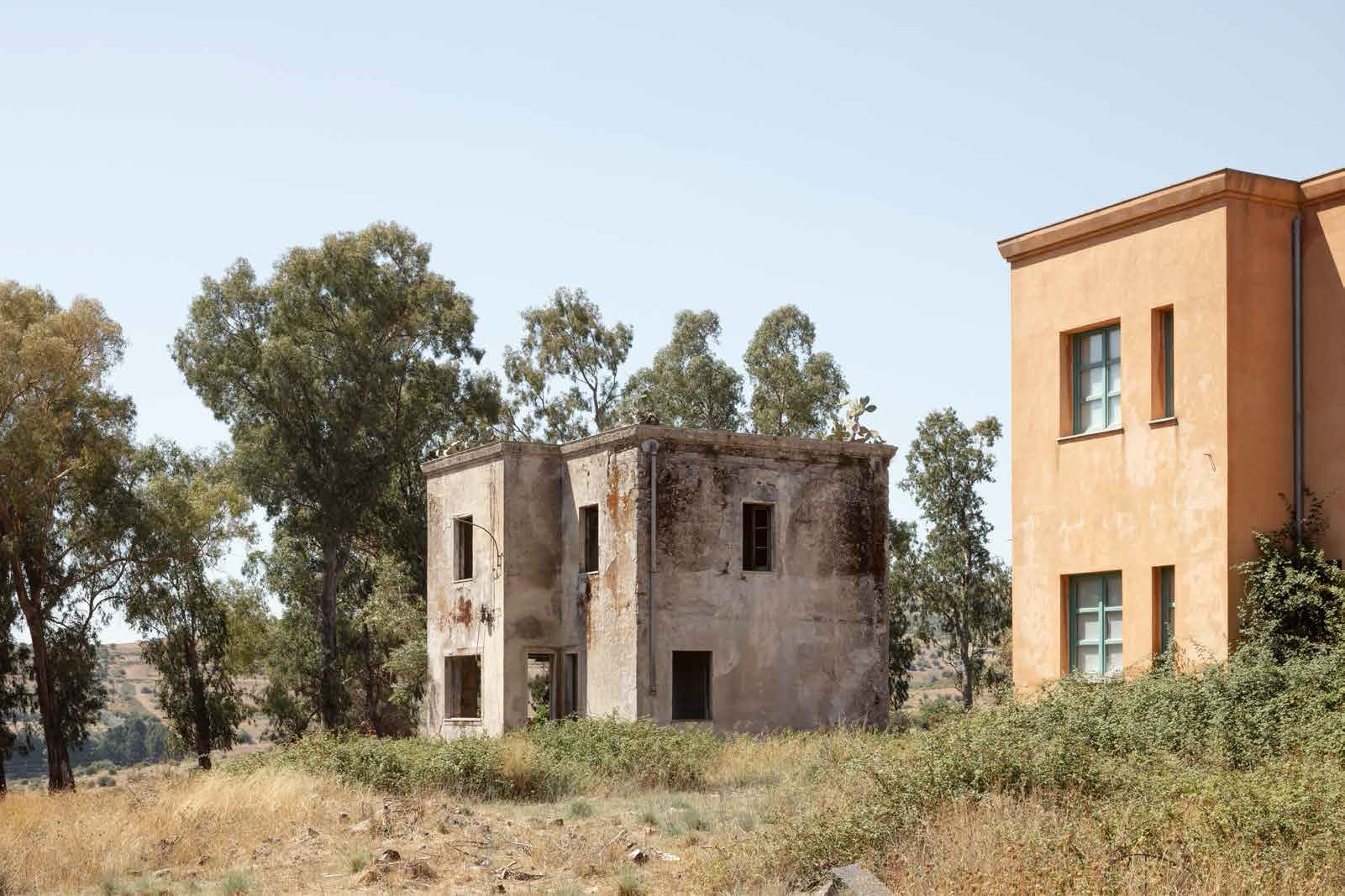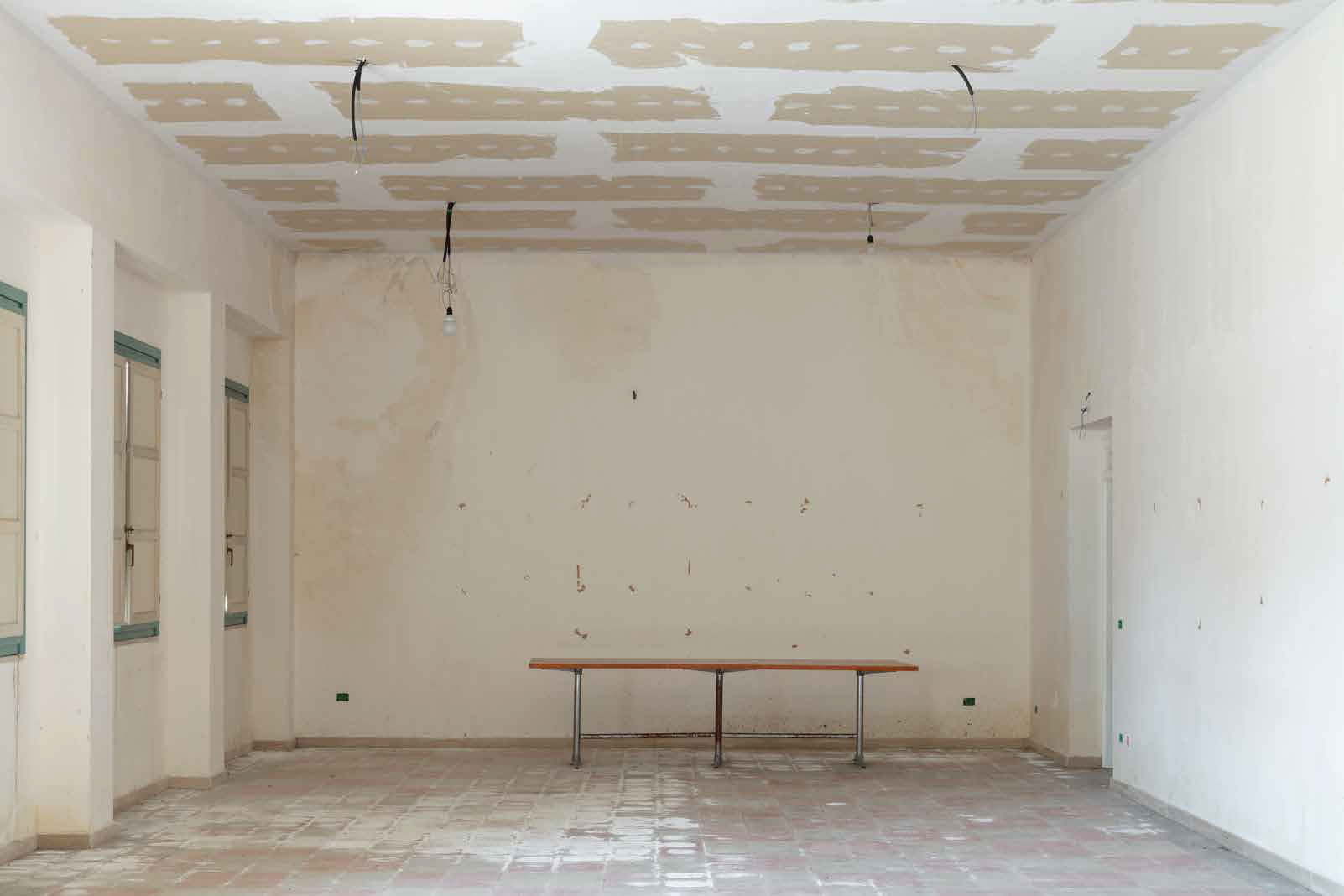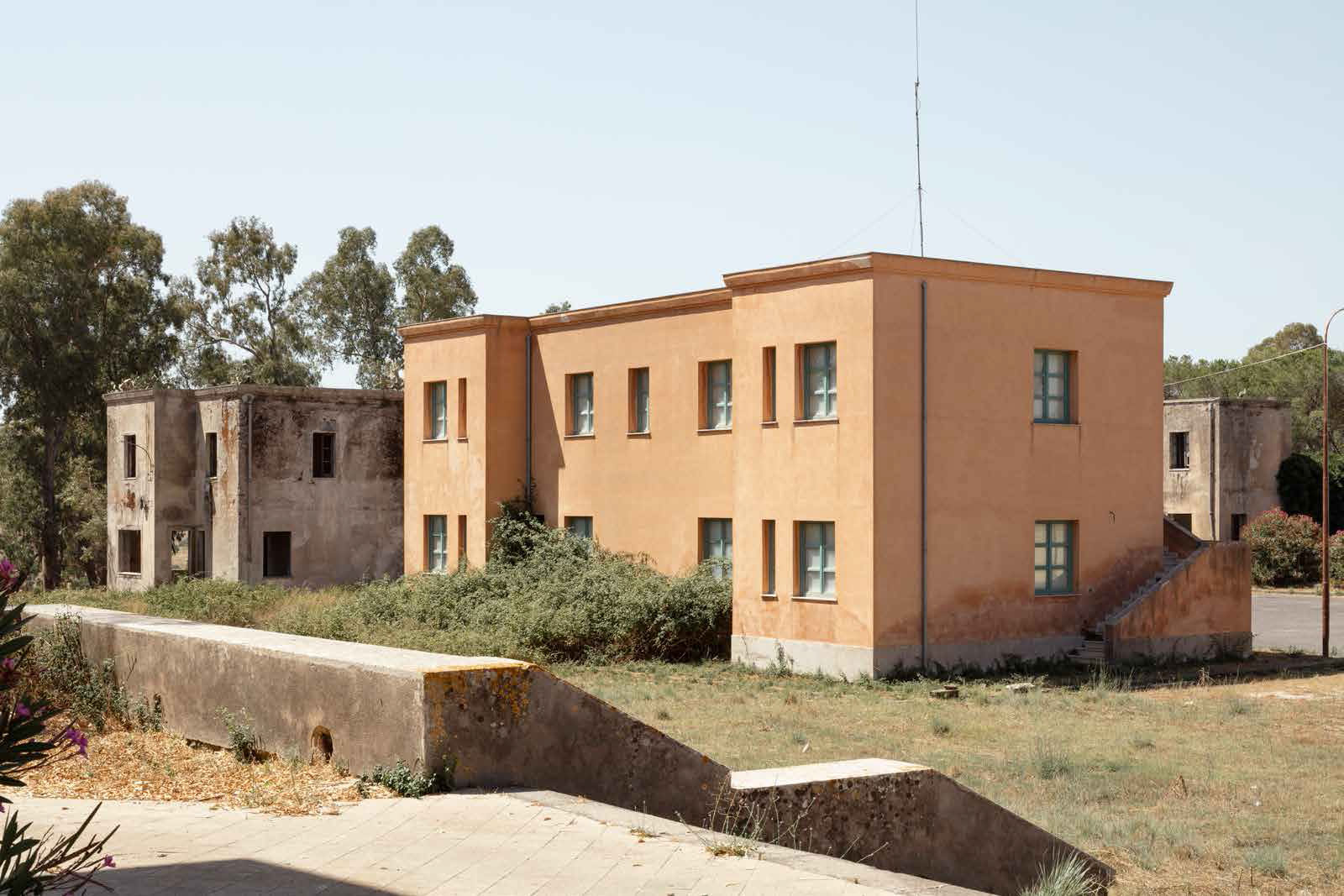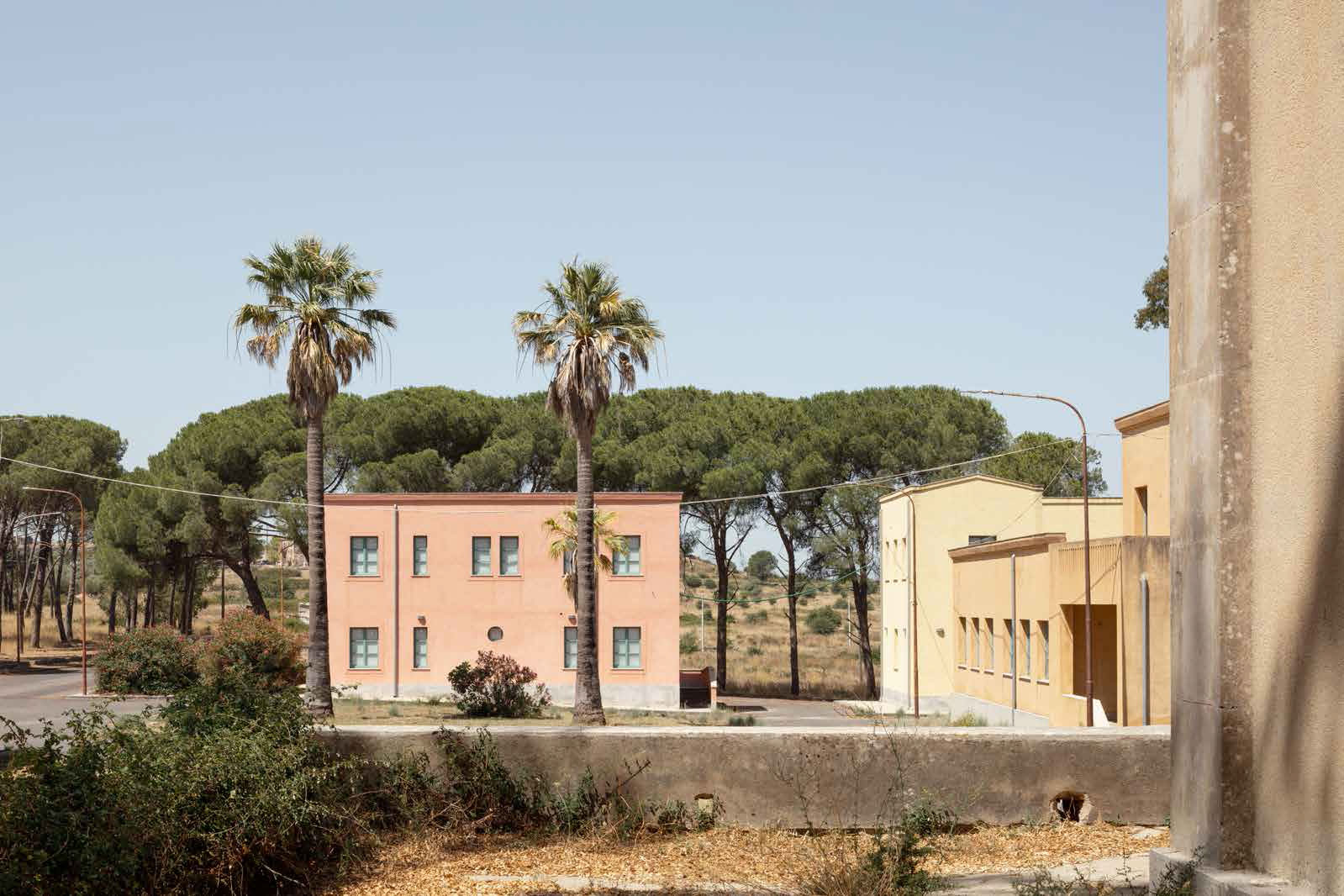ENTITY OF DECOLONIZATION
THIRD ANNUAL GATHERING
Borgo Rizza, Carlentini (SR), Sicily
May 6–10, 2024
Following on from the previous two editions of the Difficult Heritage Summer School – a collaborative effort between the Municipality of Carlentini, the Royal Institute of Art in Stockholm, the University of Basel, along with the art installation “Ente di Decolonizzazione: Borgo Rizza” by DAAR – in May 2024 the annual gathering will encompass a week-long intensive program consisting of collective learning, interventions, and performances, rooted in the three core branches of the Entity of Decolonization:
- Pedagogy
- Art and Architecture
- Commoning
This year the hosting institutions are the Municipality of Carlentini, the DAAS program at the Royal Institute of Art in Stockholm, the School of Architecture at the Royal College of Art (RCA) in London, IASPIS (the Swedish Arts Grants Committee’s International Programme for Visual and Applied Arts), DAAR (Decolonizing Architecture Art Research), and Museo delle Civiltà in Rome.
- PEDAGOGY
The Difficult Heritage Summer School III: Under Repair is jointly organized by DAAS, the School of Architecture at the RCA and IASPIS. Taking place in Borgo Rizza, the event questions and mobilizes the notion of repair around the possible reuse of buildings, monuments and environments affected by modern/colonial violence and exclusion. To do so, the School invites participants to discuss new approaches in architecture, design and preservation through the lenses of racial, social and environmental justice.
- ART AND ARCHITECTURE
A series of artistic and architectural interventions will animate the proceedings, culminating in the bonfire of the art installation “Ente di Decolonizzazione: Borgo Rizza” by DAAR (which was awarded the Golden Lion at the 2023 Venice Architecture Biennale). The public performance is a ritual to liberate the Entity of Decolonization from its fascist ghosts, and to begin a new chapter for the realization of a “decolonial house” in the vicinity of Borgo Rizza.
- COMMONING
“Casa Decoloniale” is a long-term experiment to cultivate forms of commoning that transcend conventional notions of “public” and “private”, “host” and “guest”, “local” and “foreigner”. Linked to other commoning projects initiated in Puglia (Campo Paradiso), Sweden (Summer House), and Palestine (Jericho), Casa Decoloniale is poised to materialize in the Carlentini territory in the forthcoming years.
We want to acknowledge that this gathering is happening at very difficult times. We find ourselves in an unprecedented assault on Palestinians, marked by a highly dangerous escalation led by the US government, coupled with a suppression of critical voices in Western institutions. We are entering one of the most obscure chapters of Western history. Spaces for critical conversations are closing down; we see the annual gathering as an alternative platform to continue our conversations and actions elsewhere.
Format
In accord with the open-ended nature of the Entity of Decolonization and the principle of commoning resources, each day is hosted by some of the groups taking part in the gathering.
Participants are encouraged to take part in the program either as hosts (by being fully responsible for both the conceptual and logistical aspects) or as guests (attending the program activities). Each session will be facilitated by a host who is part of the confederation. The objective is to maintain a decentralized structure and prevent logistical challenges or concentrations of responsibility. In a similar vein, guests are considered active participants.
In the mornings we will conduct working sessions in smaller groups called “learning with”, each of them led by one of the participants. These are aimed at presenting existing practices and projects as methodologies that everyone might apply to different sites. In the afternoons we will convene for collective assemblies where the morning work is discussed and shared. Dinners are a communal moment of exchange and restoration, to which everyone is invited.
If you wish to present or organize something, please feel free to contact the coordinators: entityofdecolonization@gmail.com
PRELIMINARY PROGRAM
(NOTE: the following does not include all the events that will take place during the week; the full schedule will be sent out in early May.)
Sunday, May 5
10:00-18:00 Arrivals
19:00 Opening of Difficult Heritage: Under Repair
(self-introductions, reconnecting with previous editions)
Monday, May 6
Difficult Heritage Summer School
Hosted by DAAS and RCA School of Architecture
[in English with translation]
10:00 > Learning with: An Anti-atlas of Colonial-Fascist Architecture (led
by Husam Abusalem and Stefan Fuchs)
11:00 > Learning with: The stratigraphy of Borgo Rizza (led by Silvia
Susanna, Steffie de Gaetano, Alice Pontiggia)
> Learning with: Your Decolonial Entity (led by Robin Dingemans)
> A Glossary for Repair-Work (led by Thomas Aquilina)
13:00 Lunch
17:00 Collective assembly
20:30 Communal Dinner
Tuesday, May 7
Difficult Heritage Summer School
Hosted by DAAS and RCA School of Architecture
[in English with translation]
10:00 > Learning with: Grain communities (led by Sara Pellegrini)
> Learning with: Two Hours Ago I Fell in Love (led by Sveva Crisafulli)
11:30 > Learning with: Southern landscapes (led by Megumi Nakahashi)
> Learning with: Hostis (led by Ahmed Al-Nawas)
13:00 Lunch
17:00 Collective assembly
20:30 Communal Dinner
Wednesday, May 8
Commoning the Private: Casa Decoloniale
Hosted by DAAR
[in Italian with translation]
10:00 Learning with: Campo Paradiso (led by Judith Wielander and
Luigi Coppola)
11:00 Assembly: Commoning the Private, with the participation of
the citizens of Carlentini
13:00 Lunch
15:00 Press conference with the Mayor of Carlentini
and installation of the plaque of the Entity of Decolonization
17:00 Collective walk through the old town of Carlentini
20:30 Communal Dinner
Thursday, May 9
Difficult Heritage Symposium: Under Repair
Hosted by the School of Architecture (RCA)
[in English with translation]
10:00 Decolonisation and Repair. In Palestine (led by Sandi Hilal,
Alessandro Petti, Husam Abusalem and Emilio Distretti)
12:00 Seeding the Uncommon Commons (led by Cooking Sections /
CLIMAVORE x Jameel at the RCA)
13:00 Lunch
17:00 Assembly: “Architecture of Repair ” (led by RCA and guests)
20:30 Communal Dinner
Friday, May 10
Urgent Pedagogies
Hosted by IASPIS
[in English with translation]
10:00 Learning with: Urgent Pedagogies (led by Magnus Ericson, Pelin
Tan and Amalia Katopodis)
13:00 Lunch
15:00 > Urgent Pedagogies workshop (led by Magnus Ericson, Pelin
Tan and Chiara Siravo)
> Learning with: My Fascist Grandpa (led by Laura Fiorio, Mario
Margani and Ginevra Ludovici)
17:00 Internal Assembly
18:30 Public Assembly
20:00 Performance by DAAR: Burning the Facade
21:00 Communal Dinner + closing party
SITE
The rural settlement of Borgo Rizza, near Carlentini in Southern Sicily, was built by the Fascist government in 1940. Under the aegis of the Ente di colonizzazione del latifondo siciliano (“Entity for the colonization of the Sicilian Latifundia”), its construction was part of a broader plan to “colonize” those landscapes of the Italian South – swamps and open land – that were deemed empty and unproductive, not yet touched by agricultural modernity.
Rural Sicily today embodies a contradictory geography. It belongs to the West, thus benefiting from the last remains of the welfare state – but also partaking in Europe’s regime of racialization and border controls. At the same time, it is far removed from the centers of capital accumulation and knowledge production. The region around Carlentini shares with the rest of Southern Europe paltry salaries, the shutting down of basic services, unemployment, emigration. The architectural conditions of the city itself show the scars of the impoverishment: much of the old town of Carlentini is empty, and the buildings are in disrepair after many former residents moved to larger cities, or away from Sicily altogether.
Upon these rubbles, a new ultra-extractive economy – international tourism – looms on the horizon. To appeal to tourists, local and global investors join efforts to appropriate folklore and popular traditions, which take on an identitarian, a-historical meaning – a last resort, perhaps, when more substantial possibilities of belonging and coexistence have become difficult to imagine. With tourism and emigration comes a new pace of the seasons, standing at the opposite of the traditional agricultural cycle: summer (which used to be a time of rest) is a period of hyper-activity and exhaustion (the bodily exhaustion of seasonal labourers, but also the heat and droughts).
At the same time, the legacy of peasant struggles that marked the history of Carlentini in the postwar period has nourished new forms of organizing and resistance: farmers that foster biodiversity against agri-business, associations that build for those who choose to stay, activists that oppose the infrastructuralization and militarization of the territory.
The Entity of Decolonization takes this complex territorial condition as the starting point to imagine a different role for a place like Carlentini and Borgo Rizza as sites for a commoning experiment to think and practice the decolonization of Europe from within its borders.
We ask: How can the Entity of Decolonization avoid being yet another one-off moment of intensity? What practices and temporalities can enable a decolonial discourse throughout the year? How do we avoid a nostalgic harking back to peasant tradition, and instead create our own rituals to give a different rhythm to the year? As critical spatial practitioners, can we imagine a future for towns at the edges of Europe beyond the paradigm of touristic extractivism?
As scholars and students associated with comparatively wealthy institutions of Northern Europe, how do we become aware of our position and avoid unconsciously reiterating the existing imbalances between North and South?
CONCEPT
In Fascist times the term colonizzazione was often deployed within Italy itself, reflecting the word’s Latin root in the verb colere, “to cultivate” or “to inhabit”. Under the guise of breaking up large estates and reallocating the land to small-size farms, Fascism sought to make rural Sicily into a place where capitalist agriculture modeled on Northern Italy (i.e. one based on the heavy use of pesticide and machinery, engineered seeds, irrigation and monoculture) could thrive.
Indeed, Borgo Rizza was a site to forge new relationships between built environments, land, soil, and capital. Fascism used modernist architecture to anchor these material relationships onto a new aesthetic and social reality. Borgo Rizza’s main square, like that of other new towns, was designed for social control; its facades, embodying a new generic Mediterranean style, were meant to cut all ties with age-old local forms of construction, all the while concealing a basic, even retrograde spatial organization.
The previous two editions of the Summer School took aim at the architecture of Borgo Rizza, coming up with a range of strategies to reappropriate its built dimension. We now move further and ask: What does repair mean in the epistemic and spatial reorganization of colonially ridden contexts? What will a de-modernization of the soil look like?
Under Repair
To repair means “restoring by replacing”, and refers to finding a “remedy” for something that is “torn” or “broken”. The noun repair cogently addresses the need to fix damage, an injury, loss or harm. Any act of repairing exercises a healing/redemptive power, whether of objects and buildings, territories or people. Beyond the sphere of the physical reparation of decrepit buildings and scarred landscapes, “repair” speaks to the need of future communities to tackle unresolved issues of unpunished crimes, trauma and reparations. By acknowledging the violent dimension of architecture and planning, our conversations will explore how a critical re-interpretation of architectural heritage can initiate a process of repair. Along this path, the Entity of Decolonization will address the need to achieve “epistemic justice” through the recollection of “lost” historical traces and narratives.
Repair is discussed/practiced as a form of return, where the austere buildings of fascist architecture are returned to the common use and living for diverse communities; where the spheres of politics, intimacy and domesticity blur into the public realm as collective rituals.
Several questions will inform our debates: How to reuse villages such as Borgo Rizza, built to celebrate fascist martyrs and settlers in the colonial wars in Africa? Who has the right to re-use them? How to transform them into antidotes to colonialism/fascism? What is the role of colonial/modern architecture in the process of repair? Despite an alleged “permanent immobility”, is there a place for architectural heritage in the planetary struggle for decolonization?
Commoning
The Arabic concept of Al Masha refers to a form of land use that was widespread for millennia across the Middle East and Western Asia. The central aspect of Masha was that it came to existence only through the collective, shared use of the land; as a legal entity, it stopped existing the moment people stopped cultivating the land.
Taking a cue from the history of Al Masha and other communal uses of the land, the gathering will ask: which forms of ownership and of economic (self-)organization and which systems of cultivation and growing can advance a decolonial practice?
PRACTICAL INFO
Sleeping: The Entity of Decolonization will make available a limited number of places in communal accommodation in Borgo Rizza, as well as daily collective dinners (a small monetary contribution might be requested). We will also provide a list of rooms and homes that can be booked in Carlentini.
Arriving in Carlentini:
> The closest international airport is Catania (30 km from Carlentini). The closest train station is Lentini (5 km).
> From Catania airport, you can take a direct train to Lentini station, taking 25 mins (check schedule on trenitalia.com). There is also an AST bus directly to Carlentini, duration 1 hour, departing at: 07:15 / 09:15 / 11:15 / 13:15 / 15:25 / 16:45 / 19:00 / 20:15. Note that both run Monday to Saturday only. On Sunday there is a limited service, with replacement buses by Trenitalia departing at: 11:08 / 17:08 / 19:05 / 21:17.
> We are able to pick up those without a car, but availability is limited. Please let us know if this is the case.
> There are also direct night trains leaving Milan, Bologna, Rome and Naples every evening, and arriving at Lentini the following morning or afternoon. Check times and prices on trenitalia.com.
Local transport: Borgo Rizza is located 6 km away from the town of Carlentini. We will have some form of transportation, but if at all possible for you, please consider renting a car.
> Contact: entityofdecolonization@gmail.com
Towards an Entity of Decolonization
Sandi Hilal, Emilio Distretti, Alessandro Petti
In 1940 the fascist regime established the “Entity of Colonization of Sicilian Latifundia / Ente di Colonizzazione del Latifondo Siciliano” following the model of the “Entity of Colonization of Libya,” and the colonial architecture in Eritrea and Ethiopia, and what has already been experimented with the plans of integral reclamation and “internal colonization” of the Pontine Marches around Roma. Using different forms of violence and oppression, genocidal forms against colonized peoples, and social engineering and class violence on the Italian front, fascism had identified in these “territories” an abstract, uniform, and homogeneous geographical space to “modernize” and “repopulate,” as it is considered “empty,” “underdeveloped” and “backward.” For this purpose, Sicily had become, in the eyes of fascism, the last front of modernization, whose rural world, as opposed to the city, was considered a “virgin” land to be occupied.
Before the world conflict prevented it, fascism inaugurated eight Sicilian villages until 1943, while others remained unfinished. Following the principles of modernist aesthetics and plans of fascist colonial architecture, the villages were built around the void of the square, the “civic center” of the State institutions aimed at “civilizing” the countryside considered empty and lifeless: the Church, the Post Office, the School, Casa del Fascio, the Entity of colonization, are just some of the institutions designated to forge the cultural, political and spiritual education of the “new fascist colonist”. Thus, the new founding villages would “connect” the various parts of the new Italian Empire to each other.
To celebrate this fictitious unity, many of the Sicilian villages, including Borgo Bonsignore, Borgo Fazio, and Borgo Giuliano, took the name of fascist martyrs and soldiers and settlers who died in Ethiopia during the colonial war of occupation. Simultaneously, fascism had continued the “internal colonization” as an instrument and strategy of oppressing internal dissent. If on the one hand, the villages were conceived as an instrument and space for the agricultural transformation of the Sicilian countryside in an extensive, extractive, and capitalist key, the forced migration plans to the South served the regime to prevent revolts in the northern countryside, break the ties between the agricultural workers with anti-fascist movements, and transforming laborers into small landowners.
Today most of these villages have fallen into disrepair. The depopulation and migrations of the Sicilian countryside after the war, over time, have meant that the buildings that housed the fascist institutions fell into neglect, or in some cases, were transformed by residents into homes. Today, these villages are the materialization of a suspension, not the definitive elimination of a historical and political trajectory. Despite the fall of fascism and the end of historical colonialism, Italy’s de- fascistization and decolonization remain unfortunately unfinished processes. To date, the lack of a critical review process has meant that the cultural and political apparatus of colonialism and fascism has survived: among these, institutional racism and a widespread feeling of the presumed superiority of European civilization, the consequent dehumanization of populations from the (post) colonial world, the surviving of monuments and streets that celebrate fascist and colonial ideology and history, and the lack of an education in critical knowledge of the past within the Italian educational system.
In Italy, as demonstrated by the Sicilian villages, this long-lasting political and cultural impasse is very visible through the normalization or neglect of fascist architecture. As has been debated by postcolonial critics and literature in recent years and loudly contested in 2020 on the wave of global uprisings against the presence of symbols celebrating imperial and colonial violence in urban spaces of the Northern Hemisphere, in Italy, it is very common to find colonial/fascist buildings (as well as monuments, plaques, memorials, and toponymy) which, rather than being removed, dismantled or destroyed, have been left intact. Since the end of the Second World War, fascist architecture (and urban projects) have been reused or developed by republican governments to give a home to the new Italian liberal democratic institutions. The relics of fascism and colonialism have been progressively normalized within urban landscapes, escaping the critical gaze of anti-fascist culture and politics.
To date, with the “return” of fascism on a global scale and the increasing arrival in recent decades of migrants from the former colonial world, the need to reopen the processes of decolonization and de-fascitization has become more urgent than ever. And with them, new questions on “what to do” with the fascist colonial architectural “heritage.” Is it possible to imagine reuse without running the risk of eternally perpetuating this same ideology and against the danger of self-absolution and nostalgia?
In 2017 Asmara, the capital of Eritrea was named a UNESCO World Heritage Site. The nomination, entitled “Asmara – Modernist Citizen of Africa”, refers to the colonial, fascist, and modernist architectural and urban transformation of Asmara that took place during the Italian colonial occupation. Not exempt from criticism, the Asmara inscription poses a series of problematic elements: from the risk of presenting the colonial city built by the Italians as the model of urban heritage of the African continent to the danger of reinforcing nostalgic impulses or constituting a propaganda tool for the Eritrean regime, up to the risk of yielding to the paradigms of conservation of Eurocentric architectural and cultural heritage imposed by UNESCO.
Despite these controversies, the appointment of Asmara nevertheless posed for the first time a series of fundamental questions that concern and unite both ex-colonizers and ex-colonizers: who has the right to preserve, reuse, and re-narrate fascist colonial architecture?
The art installation presented by DAAR for the 2020 Quadriennale d’Arte 2020 – FUORI at Palazzo delle Esposizioni in Rome, home to the first international exhibition of colonial art (1931) and other propaganda exhibitions of the regime, proposes to rethink the villages built by fascism in Sicily starting from the appointment of Asmara as a world heritage site. The installation is the first step towards the creation of Entity of Decolonization that will be open to those who feel the urgency to question a broad historical, cultural and political heritage steeped in colonialism and fascism, and thus start a common path towards new practices of decolonization and de-fascistization.
The installation is the first intervention, and it will be followed by a second step ”Towards a Decolonization Entity / Verso un Ente di Decolonizzazione”: the opening of a summer school, a space for critical knowledge and pedagogy, to investigate the aftermath of colonial and fascist architectural heritage. The school will take place in the summer 2021, in Borgo Rizza, Municipality of Carlentini, (Siracusa), one of the rural settlements built by fascism. The school wants to intervene in the debate regarding the architectural heritage associated with the histories of violent pasts and painful memories. It is a collaboration between the Decolonizing Architecture Advanced Course, at the Royal Institute of Art in Stockholm, the MA program in Critical Urbanisms, at the University of Basel and the local community in Carlentini. The lived experience in these towns will offer the opportunity to elaborate on a series of important questions: What should be done with such troublesome heritage? Is there a possibility for its re-use and for critical preservation without falling into the celebration of colonial/fascist ideologies? Who has the right to reuse and reclaim this heritage? Answering these questions will also help to problematize the exploitative relation of the ‘urban’ with the countryside, histories of migration and unsolved questions of (post)colonial injustice – especially after the renewed interest in the “countryside” at the time of a global pandemic.
Thus, the formation of an Entity of Decolonization wants to pose the question of the reappropriation and re-narration of the spaces and symbols of colonialism and fascism within a broad decolonial perspective, and thus contribute to reversing the Italian trend towards the self-absolving narrative of colonialism “less worse” than the others. In an international context in which the claims of the ex-colonized to true reparation and compensation for the crimes of colonialism and slavery are becoming stronger and more enthralling, the Entity of Decolonization intends to start with simple questions that make it possible to claim the right to re-frame the historical narrative, starting with the presence of the colonial and fascist architectural heritage: given that the villages were built to give shape and body to the fascist ideology, how it is possible to subvert its founding principles, starting from these same places as a new “center” of the fight against contemporary fascisms? How to transform these villages into an antidote to fascism? Who has the right to re-narrate and reuse these villages that were built to celebrate the fascist martyrs in the wars of occupation in Africa? Is it possible to imagine a critical reuse of these places, which becomes an ally of a path of reparation for the crimes of the past? Is reuse intended as a repair conceivable? Is it possible a path of reparation that goes beyond the sphere of bilateral treaties between governments and states? In what forms can this reparation or compensation take shape? Can architectural heritage play a role in all of this?
—–
Data di costruzione: inizio lavori gennaio 1940 / fine lavori ottobre 1940
Riferimento del nome del borgo: Angelo Rizza
Architetto/ingegnere: Pietro Gramignani
Possibile tipologia di borgo: Tipo A
Distretto: Tummarello, Area Carlentini, provincia di Siracusa
Coordinate: 37°13’50.4”N 15°01’26.1”E
Proprietario del terreno prima della costruzione: famiglia Cafici
Valore terreno al momento della costruzione: £ 1.520.904
Costi di costruzione: £ 1.696.800
Stato attuale: parzialmente ristrutturato
Popolazione: 0 (dati relativi al 2011)
fonti Archivio Luce: www.patrimonio.archivioluce.com
www.vacuamoenia.net/it/portfolio/borgo-rizza/
wwwvoxhumana.blogspot.com/search/label/Borgo20%Rizza
www.ascosilasciti.com/it/07/07/2016/borgo-rizza-lo-spreco-siculo-europeo
